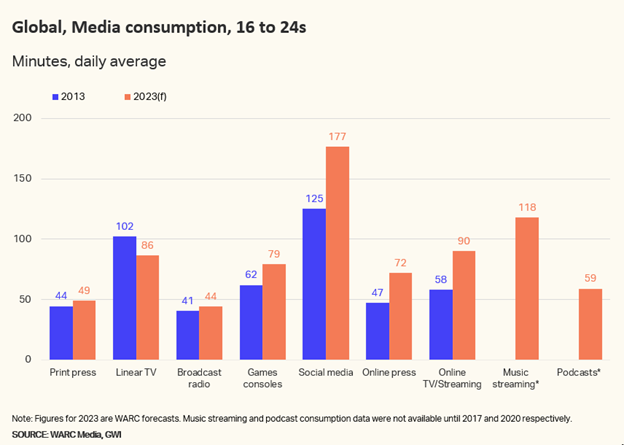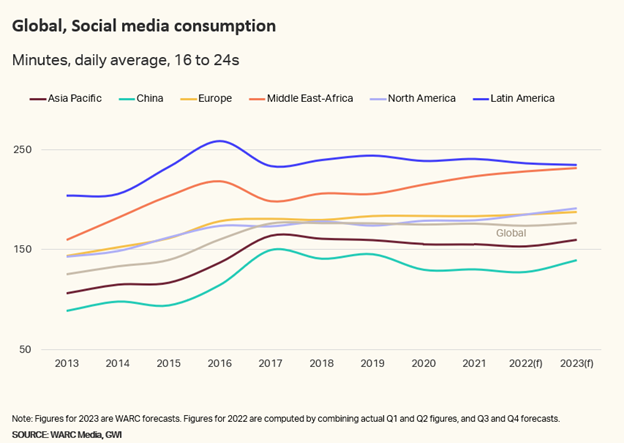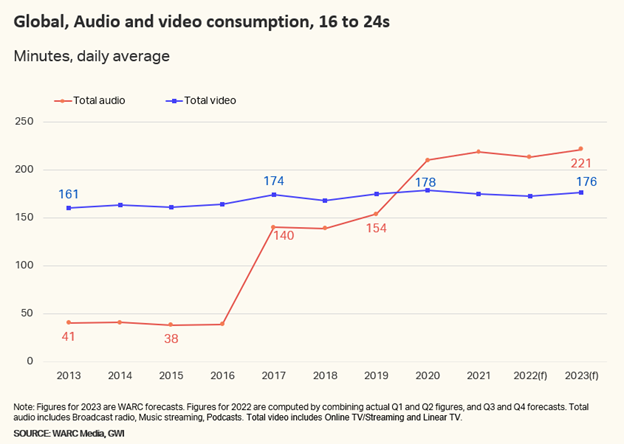The latest Global Ad Trends report looks at Generation Z through the lens of their media habits, bringing marketers on a journey to find and connect with Gen Z in conventional channels and uncustomary, fast-evolving channels.
The latest WARC Global Ad Trends analysis affirmed that Gen Z, defined in the report as consumers aged 16 to 24 years old, is the most digital demo group in their media usage. As much as two-thirds (68%) of their media time is spent online. The lead is no surprise to many, perhaps, but a closer look at their total media consumption unveils some unexpected stories and might give marketers a second thought about how to capture the Zs.
Gen Z is everywhere: from broadcast radio to podcasts, from online TV/streaming to linear TV, it’s forecasted at least 40 minutes will be spent on each channel per day, with social media consumption reaching a whopping 177 minutes in 2023.

However, their total daily average minutes spent consuming audio and visual media content lag behind older Millennials and Gen X. Since 2018, 16–24s globally have consumed less than 25–34s, and the gap is getting bigger. It’s estimated that by 2023, the 25 to 34 cohort will consume 14.4 hours of media per day compared to 13 hours among 16 to 24s. This trend can be observed across all channels bar social media and music streaming globally.
This has amplified the importance of social media as a key element to reach Gen Zs
Across all regions WARC analyses, social media tops the rankings as the most consumed channel. The volume of social usage also varies greatly across regions, with Latin America topping the chart and China and the Asia Pacific notably below the global average. Reaching and engaging them will always be a challenge for brands entering and trying to stay in this red ocean, as the tidal wave changes direction extremely fast.

TikTok, known as Douyin in China and owned by ByteDance, was only born in 2016 but has enjoyed such rapid growth that in 2021 it announced that it had more than a billion monthly users globally. Its share of consumption among Gen Z users has soared, making it one of the most popular apps – 67% of US teens use TikTok while 59% use Snapchat, according to Pew Research.
ByteDance claimed an attention-grabbing advantage – by revealing that half of its Gen Z users pay full attention to what they are doing/watching when on TikTok – which has been the centre of attention (no pun intended) among marketers. TikTok also shared that to best engage Gen Z, the focus on content creation should be around joy, happiness, and creativity – characteristics that the company said are also typical of this generation.
That this generation’s traits are reflected in their media habits can also be seen in the rapid rise of new social apps such as BeReal, where unfiltered content creation is encouraged if not required, in an effort to tackle the all-fancy-but-artificial Instagram anxiety.
The way they pursue authenticity and creativity fuels the technology adoption in media such as metaverse and AR, which in turn speeds up the evolution of Gen Z media behaviours. “Their media consumption is highly fragmented across a number of different platforms”, said Catrina Dear from the7stars. “This has led some to say that Gen Z are hard to reach, when in fact their media usage is high.”
Meet the Zs in rising channels with nascent ad propositions
One of the exciting finds from the Finding Gen Z report is that, social media aside, music streaming dominates the remainder of Gen Z’s media usage, and is forecasted to reach two hours per day in 2023 – the highest of all age cohorts.

Audio channels play a key role in reaching Gen Z, including but not limited to music streaming and podcasts. WARC finds that 16–24s globally consume more professionally-produced audio content per day than all forms of TV viewing combined. According to Spotify, the average podcast listenership among Gen Zs in the UK saw a 53% year-on-year growth in Q1 2022 and 70% of Zs in the UK said they use “audio to understand themselves better”.
This echoes the rising of Gen Z gamers. Research by Deloitte found that Zs are motivated by self-expression and the opportunity for social connections, spending 11 hours per week gaming.
Are Zs completely out of reach when it comes to offline media?
Surprisingly, the volume of offline media consumed by 16 to 24s has remained largely unchanged over the past decade, with a dip in linear TV consumption accounting for a slight decrease since 2013.
Even though globally, the 16 to 24 cohort consumes nearly 55% more on-demand/streaming TV content than it did ten years ago, viewing consumption patterns differ between regions. US ‘cord nevers’ – younger viewers who never used commercial cable TV but rely on OTT platforms – contribute to the highest regional online TV/streaming consumption. On the other side of the Atlantic, European Zs remain more loyal to linear broadcast TV.
It’s not about one channel superseding another, it’s about connection
While Gen Z is the most digital generation, they will not necessarily be the easiest to reach. Whether it’s integrating different channels into media plans or identifying the target audience, brands and marketers need to ensure they speak the right language.
A recurring theme when looking at all Gen Z research is that they care about authenticity and self-expression. The era when everyone strives to look the same seems to be gone. Gen Z has the desire to express one’s “real” self and contribute to platforms like TikTok, Twitch, and Spotify as creators, where they have control over what they create. This creates a strong sense of community: as Gen Z bounces from one platform to another, the content they consume and the beliefs they adhere to don’t easily sway.
While marketers and brands adjust their media plans to fit Gen Z, it’s never about merely finding Gen Z and stopping there. Being unapologetically true to themselves, Gen Z consumers will also expect brands to be authentic, resonating, and consistent. This generation requires industry practitioners to continuously learn, grow, and engage as they navigate and express themselves in the ever-changing media landscape which is also, eventually, shaped by them.

